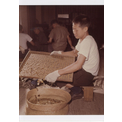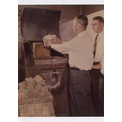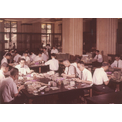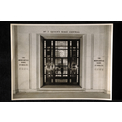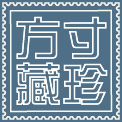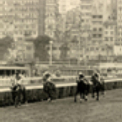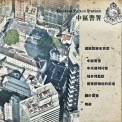 Collections
Collections Hong Kong Currency
Hong Kong Currency History of Hong Kong Currency
History of Hong Kong Currency Hong Kong's Currency after the Second World War
Hong Kong's Currency after the Second World War
After the Second World War, scarcely any coins remained in circulation in Hong Kong, as almost all of them had been seized and sent to Japan to be melted down for their metal and used in the manufacture of armaments. The Hong Kong government had to issue notes in denominations from one cent to one dollar to take their place, with new coins, carrying the portrait of King George VI, not available until 1948. More new coins were minted in 1955, this time with the bust of the recently crowned Queen Elizabeth II. The 1970s saw a total overhaul of Hong Kong’s coinage: new denominations were added, while existing ones were given new sizes and weights. Paper money also underwent landmark changes in the 1970s: the Mercantile Bank issued its last banknotes, and The Hongkong and Shanghai Banking Corporation and the Chartered Bank issued one thousand-dollar notes for general circulation. The 1980s was marked by the first issue of twenty-dollar notes by The Hongkong and Shanghai Banking Corporation and Standard Chartered Bank as well as the replacement of colonial features on banknote designs for the first time. These new banknotes also entered the history books as the first to be printed locally by the Hong Kong branch of the De La Rue Company Limited (now Hong Kong Note Printing Limited).
Coinage in Post-War Hong Kong
During the Japanese Occupation, as the actual value of Hong Kong’s cupronickel and nickel coins in circulation far outstripped their face value, almost all of them were shipped off to Japan to be melted down in support of the country’s wartime efforts. This resulted in a severe shortage of coins in Hong Kong when the British resumed its administration of the city in 1945. No coins circulated in post-war Hong Kong until 1948 when minting was resumed. With the adoption of the one-cent subsidiary note after the war and the reintroduction of the one-dollar coin in 1960, the number of denominations in circulation remained at four, ranging from five cents to one dollar. In 1975, the Hong Kong government accepted the proposal of the Coinage Review Committee to reintroduce twenty-cent coins and to add two-dollar and five-dollar coins into general circulation, and Hong Kong has had a total of seven coin denominations since that time. 1975 also saw the issue of the first one thousand-dollar commemorative gold coins by the Hong Kong government.
Paper Money in Post-War Hong Kong
After the Second World War, The Hongkong and Shanghai Banking Corporation and the Chartered Bank resumed issuing banknotes in 1946. The Mercantile Bank of India Limited soon followed suit, but only in one hundred and five hundred-dollar denominations. The note-issuing right of the Mercantile Bank was repealed in 1978, leaving two note-issuing banks in Hong Kong until 1994. The phasing out of five-dollar banknotes in 1976 and the introduction of the twenty and one thousand-dollar banknotes in 1985 and 1977 respectively mean that there have been six denominations in circulation, ranging from ten to one thousand dollars, since that time. With the adoption of the Linked Exchange Rate System in 1983, note-issuing banks now obtain their certificate of indebtedness at a fixed exchange rate of HK$7.8 to US$1. All government notes were abolished in 1969, with the exception of the one-cent note, which remained in circulation until 1995.
